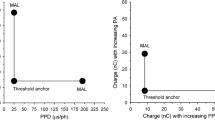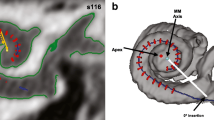Abstract
Large pH changes have been shown to be potentially harmful to tissue. The present study was designed to examine stimulus induced changes in pH for a variety of stimulus parameters both in vitro and in vivo, in order to ensure that stimulation strategies for neural prostheses result in minimal pH change. Stimulation using charge balanced biphasic pulses at intensities both within and well above maximum clinical levels for cochlear implants (0.025–0.68 μC per phase), were delivered to platinum electrodes in vitro [saline, phosphate buffered saline (PBS), or saline with human serum albumin (HSA)], and in vivo (scala tympani). Stimulus rates were typically varied from 62.5 to 1000 pulses per second (pps), although rates of up to 14,500 pps were used in some experiments. The pH level was recorded using a pH indicator (Phenol red) or pH microelectrodes. While electrical stimulation at intensities and rates used clinically showed no evidence of a pH shift, intensities significantly above these levels induced pH changes both in vitro and in vivo. The extent of pH change was related to stimulus rate and intensity. In addition, pH change was closely associated with the residual direct current (dc) level. As expected, stimulation with capacitive coupling induced little dc and a minimal pH shift. Moreover, no pH shift was observed using alternating leading phase pulse trains at intensities up to 0.68 μC per phase and 1000 pps. Saline with HSA or buffered solutions dramatically reduced the extent of pH shift observed following stimulation in unbuffered inorganic saline. Reduced pH shift was also observed following in vivo stimulation. These findings provide an insight into mechanisms of safe change injection in neural prostheses. © 2001 Biomedical Engineering Society.
PAC01: 8719Nn, 4366Ts, 4364Nf, 4364Gz, 8714Ee, 8768+z, 8717Nn, 8715Nn, 8719Bb
Similar content being viewed by others
References
Ballestrasse, C. L., R. T. Ruggeri, and T. R. Beck. Calculations of the pH changes produced in body tissue by a spherical stimulation electrode. Ann. Biomed. Eng.13:405–424, 1985.
Brummer, S. B., and J. M. Turner. Electrochemical considerations for safe electrical stimulation of the nervous system with platinum electrodes. IEEE Trans. Biomed. Eng.24:59–63, 1977.
Carter, P. M., R. K. Shepherd, and J. F. Patrick. Safety studies for a prototype nucleus 22 channel implant at high stimulation rates. Proceedings of the Third International Congress on Cochlear Implant, Pairs, 1995: 1995, p. 159.
Chesler, M., The regulation and modulation of pH in the nervous system. Prog. Neurobiol. (Oxford)34:401–427, 1990.
Donaldson, N. d. N., and P. E. K. Donaldson. When are actively balanced biphasic (“Lilly”) stimulating pulses necessary in a neurological prosthesis? II. pH changes; noxious products; electrode corrosion; discussion. Med. Biol. Eng. Comput.24:50–56, 1986.
Endres, W., P. Grafe, H. Bostock, and G. T. Bruggencate. Changes in extracellular pH during electrical stimulation of isolated rat vagus nerve. Neurosci. Lett.64:201–205, 1986.
Fernandez, C.Dimensions of the cochlea. J. Acoust. Soc. Am.24:519–523, 1952.
Guyton, D. L., and F. T. Hambrecht. Theory and design of capacitor electrodes for chronic stimulation. Med. Biol. Eng.12:613–619, 1974.
Harper, D. S., D. C. Abelson, and M. E. Jensen. Human plaque acidity models. J. Dent. Res.65Spec Iss:1503–1510, 1986.
Huang, C. Q. Neuronal damage mechanisms: Cochlear implants. PhD Dissertation, University of Melbourne. 2000.
Huang, C. Q., R. K. Shepherd, P. M. Carter, P. M. Seligman, and B. Tabor. Electrical stimulation of the auditory nerve: Direct current measurement in vivo. IEEE Trans. Biomed. Eng.46:461–470, 1999.
Huang, C. Q., R. K. Shepherd, P. M. Seligman, and G. M. Clark. Reduction in excitability of the auditory nerve following electrical stimulation at high stimulus rates. III. Capacitive versus non-capacitive coupling of the stimulating electrodes. Hear. Res.116:55–64, 1998.
Huang, C., R. Shepherd, and P. Carter. Electrical stimulation of the auditory nerve: pH changes in vivo and in vitro. Proceedings of the Twentieth Aust. Neurosci. Soc. 11:216, 2000.
Konishi, T., P. E. Hamrick, and P. J. Walsh. Ion transport in guinea pig cochlea. Arch. Otolaryngol.86:22–34, 1978.
Kraig, R. P.Acid-induced injury in elasmobranch brain. Neurosci. Lett.90:119–124, 1988.
Kuseler, A., V. Baelum, O. Fejerskov, and J. Heidmann. Accuracy and precision in vitro of Beetrode® microelectrodes used for intraoral pH measurements. Caries Res.27:183–190, 1993.
Lilly, J. C., J. R. Hughes, E. C. J. Alvord, and T. W. Galkin. Brief, non-injurious wave forms for stimulation of the brain. Science121:468–469, 1955.
Macaulay, R. B. Estimated range of current levels used by nucleus implantees. Cochlear Technical Memo no. 71, 1995.
Makimoto, K., T. Takeda, and H. Silverstein. Chemical composition in various compartments of inner ear fluid. Arch. Otorhinolaryngol.220:259–264, 1978.
McHardy, J., L. S. Robblee, J. M. Marston, and S. B. Brummer. Electrical stimulation with Pt electrodes. IV. Factors influencing Pt dissolution in inorganic saline. Biomaterials1:129–134, 1980.
Mortimer, J. T., D. Kaufman, and U. Rossmann. Intramuscular electrical stimulation: Tissue damage. Ann. Biomed. Eng.8:235–244, 1980.
Piersma, B. J., and W. Greatbatch. Coupling reaction at the metal-tissue interface in electrical stimulation with cardiac pacemaker electrodes. J. Electrochem. Soc.134:2458–2464, 1987.
Robblee, L. S., and T. L. Rose. Electrochemical guidelines for selection of protocols and electrode materials for neural stimulation. In: Neural Prostheses, edited by W. F. Agnew and D. B. McCreery. Englewood Cliffs, NJ: Prentice-Hall, 1990, pp. 25–66.
Robblee, L. S., J. McHardy, J. M. Marston, and S. B. Brummer. Electrical stimulation with Pt electrodes. V. The effect of protein on Pt dissolution. Biomaterials1:135–139, 1980.
Sherwood, L. Cellular structure and functions. In: Human Physiology from Cell to System, edited by L. Sherwood. St. Paul: West, 1989, pp. 14–57.
Swiontek, T., D. Maiman, A. Sances, S. Larson, and D. Hemmy. Effect of electrical current on temperature and pH in cerebellum and spinal cord. Surg. Neurol.14:365–369, 1980.
Sykova, E., and J. Svoboda. Extracellular alkaline-acid-alkaline transients in the rat spinal cord evoked by peripheral stimulation. Brain Res.512:181–189, 1990.
Weinman, J.Biphasic stimulation and electrical properties of metal electrodes. J. Appl. Physiol.20:787–790, 1965.
Author information
Authors and Affiliations
Rights and permissions
About this article
Cite this article
Huang, C.Q., Carter, P.M. & Shepherd, R.K. Stimulus Induced pH Changes in Cochlear Implants: An In Vitro and In Vivo Study. Annals of Biomedical Engineering 29, 791–802 (2001). https://doi.org/10.1114/1.1397793
Issue Date:
DOI: https://doi.org/10.1114/1.1397793




